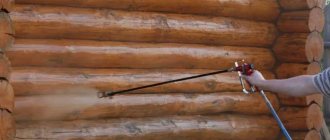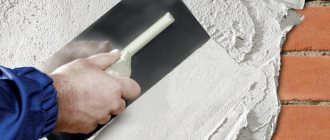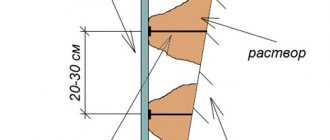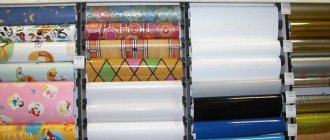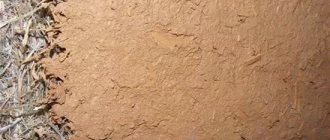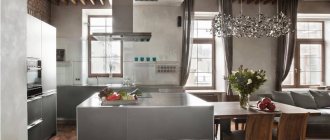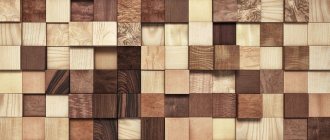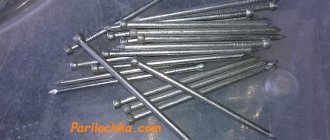10096 0 8
MesterulManole June 22, 2017Specialization: many years of experience in finishing works of residential and office premises, dachas, country cottages, etc. Hobby: cycling in all its forms
How to sheathe walls and ceilings, gypsum board or OSB: read on about this
Are you choosing structural finishing materials and don’t know which is cheaper and better? I bring to your attention an overview of the characteristics of gypsum and particle boards, which are indispensable when performing home renovations. After reading the review, you can decide which of the listed materials is suitable and which is not.
Advantages and disadvantages of drywall
Drywall consists of a layer of building gypsum laid between two cardboard sheets with a density of 0.17 - 0.22 kg/m². This structure allows you to make various arches, partitions, niches, and columns from it.
Advantages of plasterboard boards:
- safety. There are no toxic components in the composition, so the material is completely safe for humans;
- moisture resistance. Moisture-resistant gypsum board grade can be used in rooms with high humidity;
- ease of processing. The sheets can be given any shape without deforming the structure. This allows you to create arches and other non-standard designs;
- versatility. It is convenient to use plasterboard for leveling walls, and lay sound or heat insulation in the resulting voids between the wall and the sheet;
- fire resistance. GCR is resistant to high temperatures; smooth surface. The sheets are suitable for any finishing: wallpaper, paint, plaster, tiles.
Disadvantages of gypsum boards:
- Even the moisture-resistant class of gypsum plasterboard eventually ceases to withstand moisture. The sheets are not recommended for installation in bathrooms without additional moisture-proof finishing. Otherwise, the drywall will become moldy and begin to deteriorate;
- plasterboard is a fragile material that requires additional reinforcement with fastening guides during installation;
- sheets require mandatory finishing: grouting joints and recesses.
Ceiling made of OSB boards and its finishing: options
Finishing for OSB boards can be used in a similar way to that used for all wood substrates. The best option is painting or plastering (with a mandatory primer layer). It is not prohibited to use vinyl wallpaper, but you should take into account the texture of the OSB surface.
It is also possible to use foam tiles with threads. In general, it can be attached to the adhesive base of turning varnish - this will be quite enough.
If decorative plaster is used, then preference should be given to one that belongs to the class of relief putties. These are inexpensive, and the choice on the consumer market is very huge.
In total, regarding finishing, it is recommended to use the following materials (in the recommended order):
- MDF panels;
- polystyrene foam and its derivatives;
- decorative thin-layer plaster;
- multicolor coatings;
- stretch film;
- liquid or non-woven wallpaper;
- water-based paint (although “rubber paint” is also acceptable).
According to fashion trends, laminate can be successfully used as a finishing material for ceilings. Read about it: whitestrip.ru
It is better to entrust the choice to a professional designer, who will compare the proposed finish with the already created interior design of a particular room.
Are OSB boards reliable? In principle, in terms of durability they are inferior to both drywall and plastic. But with proper care (priming at least once every 5 years), they will last for many decades. It should also be mentioned that OSB boards contain wax or paraffin, which, like sponges, absorb and neutralize unpleasant odors. That is why they are recommended to be mounted, for example, in the kitchen.
Advantages and disadvantages of OSB
OSB boards consist of several perpendicularly arranged sheets of compressed wood chips with connecting resins. This structure gives the material high strength. This allows the use of oriented strand boards for external and internal cladding, construction of houses, baths, and formwork.
Advantages of OSB:
- high bending strength without cracking;
- the presence of moisture-resistant OSB classes, which are used for finishing baths, bathrooms, and kitchens;
- strong fastening with self-tapping screws, simple processing of slabs;
- suitable for any finishing;
- durability with the correct installation technology;
- suitable for installation of different types of floors;
- not subject to shrinkage.
Cons of sheets:
When heated, OSB can release harmful formaldehydes that are hazardous to health. Therefore, OSB cannot be used for finishing in baths.
Fastening OSB boards to walls inside the house. Technology of internal cladding with OSB sheets.
Before talking about the technical details and intricacies of internal cladding with OSB or OSB boards (aka OSB, OSB sheets), it is worth thinking about the feasibility of this event. Installation of OSB boards indoors takes place in two cases, namely:
- If you have a frame house and the frame has not yet been sheathed.
- If the pattern and texture of OSB boards are a decorative element.
If you just need to level the walls, then plasterboard is better suited for this purpose, since it is cheaper and more convenient to work with during installation and further finishing.
Technologies for external cladding of a house are described in the article: fastening OSB boards from the outside. Here we will consider the issue of proper installation of OSB boards on the walls inside the house.
How to sheathe a ceiling with OSB boards is described in detail on the page: filing OSB sheets to the ceiling.
Comparison of gypsum board and OSB
To understand which is better, plasterboard or OSB for interior decoration and exterior cladding of a building, you need to compare both materials according to different parameters:
- Scope of application. GCR and OSB can be used for any construction purposes: interior and exterior decoration, installation of arches and partitions. For rooms with high humidity, moisture-resistant classes of slabs can be used.
- Safety. In the absence of violations during production, both materials are safe for humans.
- Moisture resistant. Although both materials can be used in damp rooms, they are more resistant to damage, as well as the appearance of mold, OSB class 3 and especially 4.
- Strength. Due to their multi-layer structure, oriented strand boards are much stronger than plasterboard.
- Treatment. Both materials are easy to process and install.
- Sound and heat insulation. OSB and gypsum board (acoustic class) have an equally good effect.
Let's talk about the shortcomings
Despite the huge number of advantages, plasterboard as a material used for interior decoration also has some disadvantages:
- It is impossible to hang heavy objects on walls made of plasterboard sheets without prior preparation and compliance with installation rules - paintings, wall cabinets, TV, mirror, shelves;
Sheet cutting
Note! Each individual situation has its own step-by-step instructions that will help you cope with the task of hanging heavy objects on plasterboard walls without any problems.
- deformation of the slabs when trying to fasten heavy objects to the walls;
- When cutting sheets into pieces, small construction debris appears. Therefore, all work on cutting plasterboard should be carried out with special safety glasses, and also cover your mouth with a mask;
- reducing room space by assembling the frame.
If desired, all these negative aspects of working with the material, in addition to reducing space, can be leveled out. To do this, you must strictly follow the appropriate step-by-step instructions.
Material selection
Both materials have many advantages and are widely used in construction. For different purposes, you need to choose the appropriate material: OSB or plasterboard. For walls, a durable, moisture-resistant OSB board is better suited. It is also mainly used in the construction of buildings and leveling floors. GCR is used for interior decoration and the formation of non-standard structures. The main thing is to choose safe materials of high strength class. This will allow for durable repairs and high-quality finishing.
What to choose - OSB or plasterboard?
When choosing a suitable material, you should be guided by the following principles:
If load-bearing properties of any kind are required (from further laminate coating to future placement of the TV), drywall will not work. Or you should prepare to further strengthen it in various ways;
If moisture resistance and vapor permeability are required for finishing walls, floors or ceilings in the kitchen, bathroom or veranda, it is better to choose plasterboard, since OSB is not suitable for work in such rooms;
It is better to place drywall in a children's room, since it is environmentally friendly and safe.
In other cases, you should choose based on your situation, budget and plans for further finishing.
Oriented strand boards and gypsum boards are widely used in construction. Both materials are used to form partitions, walls, and external cladding. Due to the similar scope of application, it is difficult to choose a material - OSB or plasterboard, which is better to use in repairs. To understand this, you need to study the pros and cons of building materials.
Why is plaster still relevant?
It would seem that this finishing material should have long ago and hopelessly lost its position as morally obsolete. However, it continues to be used, and in the age-old rivalry of which is more reliable and better: plaster or drywall, it confidently holds its own on a par with its competitor. And all because he has some qualities that are inaccessible to him.
- If the plastering work is carried out at the proper level, you won’t have to return to it again for about 30 years. Yes, you will change the wallpaper, re-paint or re-tile the tiles, but there will be no need to restore the base.
- The high cost of plastering work is the main argument when choosing between plaster and plasterboard sheets. However, this is a myth, blown out of proportion. The work of a professional, naturally, is not cheap. However, drywall experts will also cost you a pretty penny. But in terms of consumables, plaster is simply incomparable to gypsum board. If we consider impartially, it will cost 2-2.5 times cheaper than the famous designs.
- When choosing between plaster or gypsum board, first of all you should think about the reliability of the resulting surfaces. The first one is shock resistant and absolutely indifferent to water. The second one can be broken by hitting it well with your elbow, but moisture causes it to swell and become deformed.
- The main advantage of plaster is that you can safely attach any heavy objects to it, from air conditioners and water heaters to heavy bookshelves and cupboards.
Disadvantages of plaster mixture
However, nothing is perfect in the world. Drywall strengthens its position due to the inherent disadvantages of plaster.
- Plastering is a dirty process that requires cleaning, and not only in the room where the work is being done: traces of it somehow spread unnoticed throughout the apartment.
- An important argument against plastering is the delay in time. Before you begin the final finishing, you need to wait until it dries.
- With large defects in the walls, it is extremely difficult to achieve their smoothness with a layer of plaster.
- And the main thing: without being a professional builder, you are unlikely to be able to accurately determine how well the plasterer did his job. All the troubles will appear when painting or wallpapering, when it will be too late to make a claim.
Decorative interior elements made of plasterboard
Drywall on the walls of an apartment without a frame
If you want to make columns from plasterboard, then you will need a profile. Installation of the structure is done using crabs and self-tapping screws. It is necessary to make a reliable fastening to the floor. Place vertical strips at the seams. Crabs are placed from the inside.
After this, begin installing the plasterboard column with slabs. Seam tape is not suitable. A perforated L-profile is required. It aligns vertically and provides strength. Fiberglass is used to strengthen the surface. Place it correctly vertically. If you use a standing beam under the column, then a frame is not needed.
If desired, niches are made in the wall from plasterboard. For this purpose, slabs of medium thickness are selected. When making a plasterboard shelf inside the recess, cover its end with decorative tape. Dimensions cannot exceed the distance from the wall to the frame.
Fasteners using crabs. After finishing the seams with tape, you can glue them to plasterboard shelves. To create niches and columns, a wooden frame under plasterboard is used.
